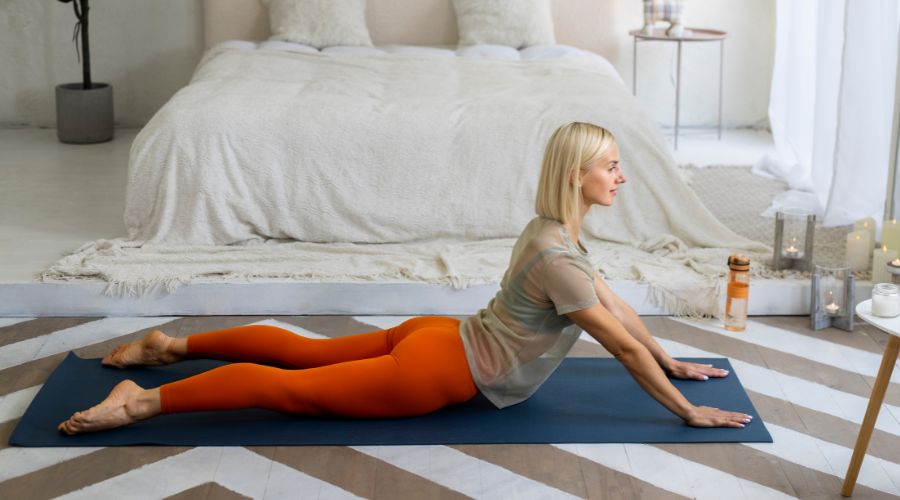Baby Cobra Pose Guide: Steps, Benefits & Tips

Do you spend long hours sitting at a desk, hunched over your laptop or phone? This modern lifestyle often causes back stiffness, poor posture, and shallow breathing. Many people jump into advanced yoga poses to fix this—only to strain their spine further.
The solution lies in a gentle yet powerful posture: Baby Cobra Pose (Ardha Bhujangasana).
Unlike deeper backbends, Baby Cobra Pose is beginner-friendly, safe for most body types, and scientifically proven to strengthen your spine, open your chest, and release stress.
In this guide, we’ll cover everything you need—from benefits and variations to mistakes to avoid—so you can confidently add Baby Cobra Pose to your yoga practice.
What Is Baby Cobra Pose?
Baby Cobra Pose, or Ardha Bhujangasana, is a gentle backbend commonly practiced in Hatha yoga, Vinyasa, and beginner yoga sequences. Unlike the full Cobra (Bhujangasana), where the arms straighten, Baby Cobra keeps a lower lift, emphasizing strength in the back muscles instead of arm pushing.
This makes it ideal for:
Beginners new to yoga
People recovering from back stiffness
Anyone looking for a safe entry into backbends
Benefits of Baby Cobra Pose
Practicing Baby Cobra Pose regularly offers both physical and mental benefits:
Spinal Health – Improves flexibility, mobility, and alignment of the spine.
Back Strength – Activates erector spinae and stabilizing muscles without strain.
Chest & Lung Expansion – Opens the chest, improving breathing capacity.
Stress Relief – Gentle heart opener that calms the nervous system.
Posture Correction – Counteracts slouching from desk jobs or phone use.
Digestive Support – Light compression on the abdomen may stimulate digestion.
Lower Back Pain Relief – When practiced correctly, it strengthens instead of compressing.
Latest 2025 insight: Physiotherapists now recommend Baby Cobra Pose as part of digital detox routines to reverse “tech neck” and sitting-related posture issues.
Step-by-Step Guide: How to Do Baby Cobra Pose
Follow this actionable checklist for correct alignment:
Lie on your stomach – Forehead on the mat, legs extended long.
Feet placement – Keep heels hip-width apart, tops of feet pressing down.
Pelvis grounding – Gently press your pubic bone into the mat.
Hand position – Place palms under shoulders, fingers spread wide.
Elbows in – Hug them close to your rib cage.
Engage core – Draw navel toward spine for stability.
Lift with breath – Inhale, slowly raise chest and head using back muscles, not arms.
Shoulders relaxed – Slide them down, away from ears.
Neck alignment – Keep chin slightly tucked, gaze forward or down.
Breathe deeply – Hold for 3–5 breaths, then exhale to release.
Repeat 3–5 rounds, linking breath with movement.
Variations of Baby Cobra Pose
Gentle Support – Place a folded blanket under ribs for comfort.
Wider Legs – Reduce pressure on lower back by moving feet apart.
Hands Wider – Place palms slightly forward/outside mat to activate upper back.
Dynamic Flow – Lift on inhale, lower on exhale for a moving meditation.
Prop Variation – Use yoga blocks under hands for reduced strain.
Common Mistakes to Avoid
Even though Baby Cobra Pose is simple, beginners often make errors that reduce its benefits:
- Pushing with arms instead of back muscles
- Overarching the lower back (causes pain instead of relief)
- Shrugging shoulders toward ears (creates neck tension)
- Holding breath (limits oxygen flow)
- Lifting legs or squeezing glutes too hard
Tip: Always keep the lift low and gentle—it’s Baby Cobra Pose, not full Cobra!
Expert Tips for a Safe Practice
Practice on a firm yoga mat to protect your spine.
Warm up with Cat-Cow Pose or Child’s Pose before Baby Cobra.
Pair with Downward Dog to balance backbends with forward stretches.
Add to your morning routine for an energy boost.
If you have a slipped disc, recent surgery, or severe back pain, consult a doctor first.
Real-Life Example: A Case Study
Sarah, a 32-year-old graphic designer, struggled with upper back pain from 10-hour desk shifts. Instead of advanced yoga poses, her instructor recommended Baby Cobra Pose for 5 minutes daily.
After 6 weeks, Sarah reported:
Noticeable improvement in posture
Reduction in mid-back stiffness
Better breathing capacity during cardio workouts
This case highlights how even beginners can transform spinal health with consistent Baby Cobra Pose practice.
Baby Cobra Pose vs. Cobra Pose (Key Difference)
| Pose | Backbend Depth | Arm Involvement | Best For |
|---|---|---|---|
| Baby Cobra Pose | Gentle, low lift | Minimal (back muscles lead) | Beginners, posture correction, safe spinal strengthening |
| Cobra Pose | Deeper backbend | Stronger push from arms | Intermediate to advanced yogis, deeper chest opening |
FAQs
1. Is Baby Cobra Pose safe for beginners?
Yes! It’s one of the safest backbends for new yoga practitioners.
2. How long should I hold Baby Cobra Pose?
Start with 2–3 breaths. With practice, hold for 20–30 seconds.
3. Can Baby Cobra Pose relieve back pain?
Yes, when done correctly. But avoid it if you have acute injuries—consult a doctor first.
4. What’s the difference between Baby Cobra and Sphinx Pose?
Sphinx uses forearms on the mat, while Baby Cobra engages back muscles with hands near shoulders.
5. Should I do Baby Cobra every day?
Daily practice (2–5 minutes) is highly beneficial for posture and stress relief.
Conclusion
The Baby Cobra Pose is more than just a yoga warm-up—it’s a gentle but powerful tool for spinal health, stress relief, and improved posture. By practicing consistently and avoiding common mistakes, you can unlock its full benefits in just a few weeks.
Ready to deepen your yoga journey? Start with Baby Cobra Pose today and explore our other beginner-friendly yoga guides to build a strong, flexible, and stress-free body.
